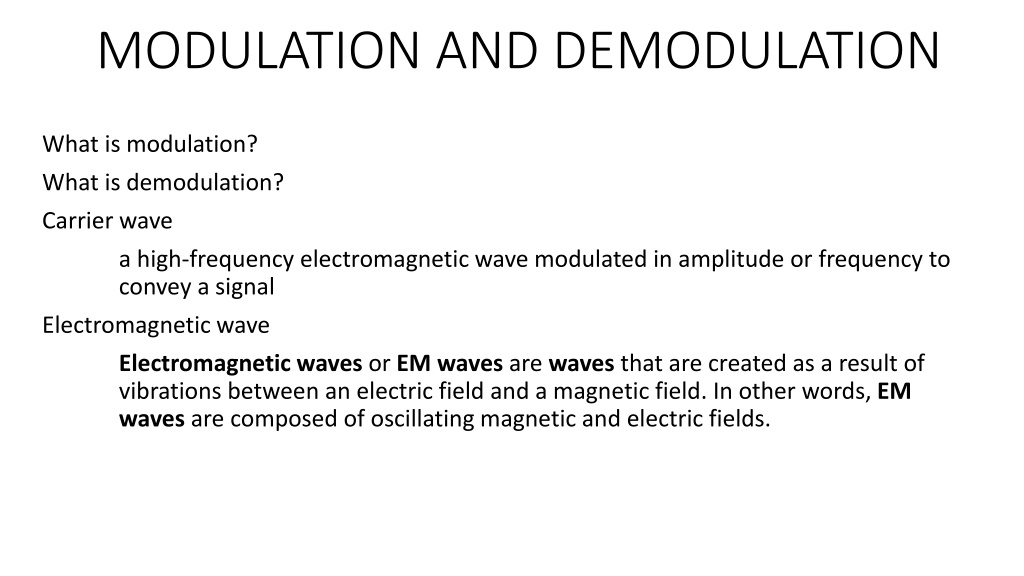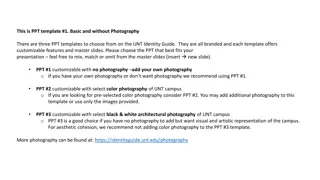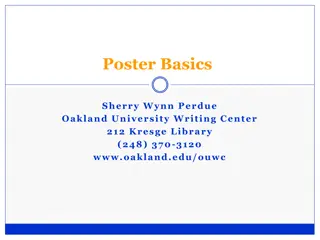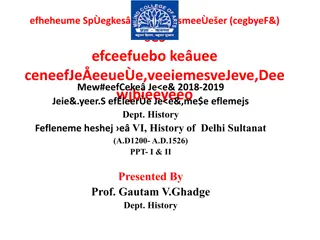
Understanding Modulation and Demodulation
Learn about modulation and demodulation processes in telecommunications, where signals are encoded and transmitted through carrier waves. Explore various types of modulation techniques such as amplitude, frequency, and phase modulation, along with their applications.
Download Presentation

Please find below an Image/Link to download the presentation.
The content on the website is provided AS IS for your information and personal use only. It may not be sold, licensed, or shared on other websites without obtaining consent from the author. If you encounter any issues during the download, it is possible that the publisher has removed the file from their server.
You are allowed to download the files provided on this website for personal or commercial use, subject to the condition that they are used lawfully. All files are the property of their respective owners.
The content on the website is provided AS IS for your information and personal use only. It may not be sold, licensed, or shared on other websites without obtaining consent from the author.
E N D
Presentation Transcript
MODULATION AND DEMODULATION What is modulation? What is demodulation? Carrier wave a high-frequency electromagnetic wave modulated in amplitude or frequency to convey a signal Electromagnetic wave Electromagnetic waves or EM waves are waves that are created as a result of vibrations between an electric field and a magnetic field. In other words, EM waves are composed of oscillating magnetic and electric fields.
Modulation converting data into radio waves by adding information to an electronic signal. A carrier signal is one with a steady waveform constant height, or amplitude, and frequency.
Need for modualation 1: Transmission of signal to longer distance : To have maximum amplitude and frequency which is impossible to acquire from original signal.
Encoding and modulation Encoding: Converting digital or analog data to digital signal Modulation: Converting digital or analog data to an analog signal. Encoding : Used to ensure efficient transmission and storage Modulation : Used to send the signals to a long way
Modulation and Demodulation Modulation Encoding information in a transmitted signal Demodulation Extracting information from the transmitted signal.
Types of Modulation Amplitude Modulation Frequency Modulation Phase Modulation
Amplitude Modulation Applications: Used to carry message signals in early telephone lines. Used to transmit Morse code using radio and other communication systems. Used in Navy and Aviation for communications as AM signals can travel longer distances.
Amplitude Modulation the amplitude of the carrier wave varies with proportion to the base waveform that is being transmitted. Types Double Sideband Suppressed Carrier(DSB SC) Double side-band full carrier (Traditional Amplitude Modulation) Quadrature Amplitude Modulation (QAM) Single sideband (SSB) Vestigial sideband (VSB)
Frequency Modulation Frequency modulation (FM) Is a technique used to encode data on an alternating digital or analog signal. The method includes varying the frequency of the carrier wave on which useful information is imposed or impressed upon.
Phase modulation Phase modulation Used for transmitting radio waves and is an integral part of many digital transmission coding schemes that underlie a wide range of technologies like Wi-Fi, GSM and satellite television.
Superheterodyne receiver The superheterodyne receiver operates by taking the signal on the incoming frequency, mixing it with a variable frequency locally generated signal to convert it down to a frequency where it can pass through a high performance fixed frequency filter before being demodulated to extract the required modulation or signal.
Superheterodyne is basically a process of designing and constructing wireless communications such as radio receivers by mixing two frequencies together in order to produce a difference frequency component called as intermediate frequency (IF), so as to reduce signal frequency prior to processing.
AM Transmitter Amplitude modulation (AM) is a modulation technique used in electronic communication used transmitting information via a radio carrier wave. ...
Frequency Modulation transmitter: The transmitters are those devices which is used to send frequency modulated wave through a band and receivers are the devices which received modulated signal then after demodulation it gives us the original signal.Jul 8, 2015
Receiver: The heart of a typical home theater system. The receiver sends the video on to your television sends the audio to the decoder. The decoder sorts out the different sound channels from the video signal Then sends the information to amplifiers for each sound-channel output.






















